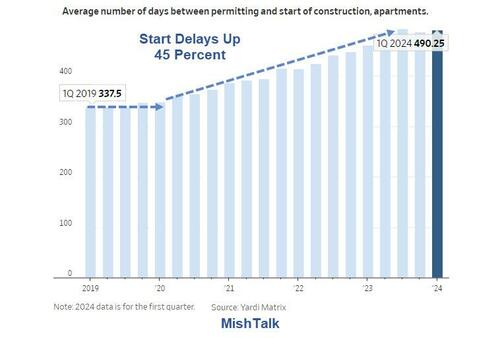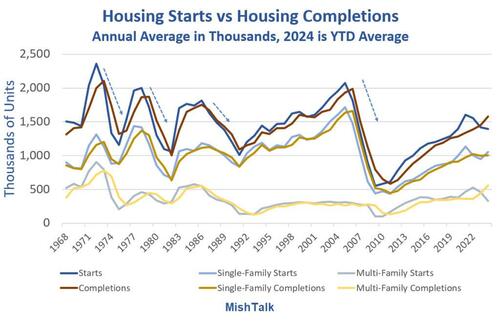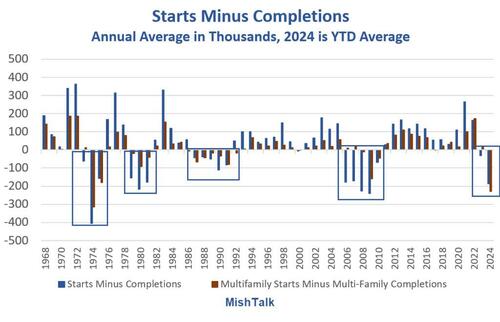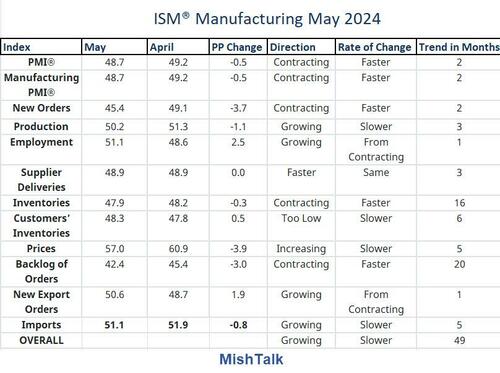
By Mish Shedlock of Mishtalk
Interest rates are too high for many projects to start. Some started projects are in trouble. Let’s discuss the ramifications.
The Wall Street Journal reports Developers Sit on Empty Lots After Historic Apartment Boom
During the biggest apartment construction boom in decades, a growing number of developers can’t make the numbers work to get started on their project, or can’t get the money to complete them. Higher interest rates, tighter lending conditions and flattening rents in parts of the country have left property companies from California to Florida waiting for financing that might not come soon.
The amount of time the average apartment project spends between construction authorization and when construction begins has risen to nearly 500 days, a 45% increase from 2019, according to property data firm Yardi Matrix.
“We certainly are seeing a decline in construction,” said Robert Dietz, chief economist at the National Association of Home Builders. “Deals and financing have dried up.”
Some decline was inevitable. About half a million new apartments opened in 2023, the most in 40 years. Based on what is already under construction, analysts expect a similar number to be completed in 2024.
But banks have other issues that keep them from lending as much to apartment builders this year. Many regional banks are souring on the commercial real-estate loans already on their books.
“Their current portfolios are getting marked down and they don’t have that much to lend,” said David Frosh, chief executive of Fidelity Bancorp Funding, a California real-estate lender.
That means developers need to raise more cash from investors to build. But many investors are more cautious today, as rent growth flattens and new projects look less profitable at today’s higher interest rates and construction costs.
“The numbers don’t add up,” Frosh said.
Housing Starts vs Completions Looks Ominous for the Economy
On May 16, 2024, I commented Housing Starts vs Completions Looks Ominous for the Economy
Housing completions have surpassed housing starts. History suggests bad things follow. But what’s happening this time?
Starts Minus Completions
Whether it’s all completions or just multi-family that matters the most, it doesn’t look very good either way.
Economic Ramifications
- Slowdown in construction employment.
- Slowdown in loans.
- Writeoffs on struggling projects. The WSJ mentioned several. There will be many.
- Apartment construction loans will add to the misery of regional banks suffering on commercial real estate loans.
- Huge slowdown in durable goods needs coming up: Appliances, furniture, light fixtures, etc.
This is happening as a major slowdown in EVs is also underway.
ISM Manufacturing New Orders and Backlogs in Steep Contraction
Yesterday, I noted ISM Manufacturing New Orders and Backlogs in Steep Contraction
The Manufacturing ISM was in contraction for 16 months went positive for a month and is contracting again for two months with order backlogs falling for 20 months.
Order backlogs have plunged. New orders are sinking. This will impact employment. The economy is now struggling on multiple fronts simultaneously.
By Mish Shedlock of Mishtalk
Interest rates are too high for many projects to start. Some started projects are in trouble. Let’s discuss the ramifications.
The Wall Street Journal reports Developers Sit on Empty Lots After Historic Apartment Boom
During the biggest apartment construction boom in decades, a growing number of developers can’t make the numbers work to get started on their project, or can’t get the money to complete them. Higher interest rates, tighter lending conditions and flattening rents in parts of the country have left property companies from California to Florida waiting for financing that might not come soon.
The amount of time the average apartment project spends between construction authorization and when construction begins has risen to nearly 500 days, a 45% increase from 2019, according to property data firm Yardi Matrix.
“We certainly are seeing a decline in construction,” said Robert Dietz, chief economist at the National Association of Home Builders. “Deals and financing have dried up.”
Some decline was inevitable. About half a million new apartments opened in 2023, the most in 40 years. Based on what is already under construction, analysts expect a similar number to be completed in 2024.
But banks have other issues that keep them from lending as much to apartment builders this year. Many regional banks are souring on the commercial real-estate loans already on their books.
“Their current portfolios are getting marked down and they don’t have that much to lend,” said David Frosh, chief executive of Fidelity Bancorp Funding, a California real-estate lender.
That means developers need to raise more cash from investors to build. But many investors are more cautious today, as rent growth flattens and new projects look less profitable at today’s higher interest rates and construction costs.
“The numbers don’t add up,” Frosh said.
Housing Starts vs Completions Looks Ominous for the Economy
On May 16, 2024, I commented Housing Starts vs Completions Looks Ominous for the Economy
Housing completions have surpassed housing starts. History suggests bad things follow. But what’s happening this time?
Starts Minus Completions
Whether it’s all completions or just multi-family that matters the most, it doesn’t look very good either way.
Economic Ramifications
- Slowdown in construction employment.
- Slowdown in loans.
- Writeoffs on struggling projects. The WSJ mentioned several. There will be many.
- Apartment construction loans will add to the misery of regional banks suffering on commercial real estate loans.
- Huge slowdown in durable goods needs coming up: Appliances, furniture, light fixtures, etc.
This is happening as a major slowdown in EVs is also underway.
ISM Manufacturing New Orders and Backlogs in Steep Contraction
Yesterday, I noted ISM Manufacturing New Orders and Backlogs in Steep Contraction
The Manufacturing ISM was in contraction for 16 months went positive for a month and is contracting again for two months with order backlogs falling for 20 months.
Order backlogs have plunged. New orders are sinking. This will impact employment. The economy is now struggling on multiple fronts simultaneously.
Loading…








